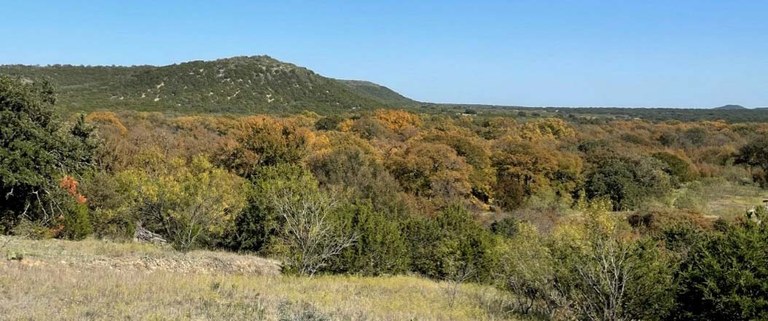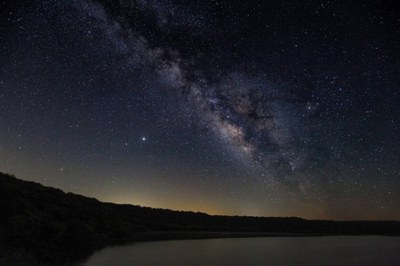Nature
What Rocks Have to Say
Stone as stationary...
 About 320 million years ago, layers of loose sand and dirt settled at the bottom of an ancient ocean floor. Beneath the immense weight of the water, the layers fused together into sedimentary rock.
About 320 million years ago, layers of loose sand and dirt settled at the bottom of an ancient ocean floor. Beneath the immense weight of the water, the layers fused together into sedimentary rock.
As time passed, underground forces pushed these rock layers upward, squishing and folding them against the movement of the ocean currents. This created our unique hills, which have a gradual incline on one side and a sudden, steep drop on the other.
The term for this land formation is “cuesta,” which roughly translates to mean “slope.” In our park, these cuestas peak at 1,400 feet!
...written with water
Over a long period of time, the ocean retreated, and newer bodies of water carved a path through the landscape. Starting in Eastland County, Russell Creek comes up from our southern border to join Palo Pinto Creek near our headquarters building. Palo Pinto Creek meanders along our northern border and beyond.
Throughout our park, you can see the small canyons these two creeks carved into the surrounding limestone walls.
Western Cross Timbers
Located in the Western Cross Timbers ecoregion, Palo Pinto Mountains State Park contains a special collection of rock formations, plants, animals and habitats. From the juniper-topped hillsides to the hardwood bottomlands—and every pocket prairie and plateau in between—you’ll find diverse terrain when you visit the park.
Painting with plants
Springtime paints our trails with Indian blanket, yellow coneflowers, white prickly poppies, lemon beebalm, evening primrose and many other wildflowers. In fall, red oak and flameleaf sumac turn deep red, while pecans and cedar elms shift to golden-yellow. Watch for barrel cactus, prickly pear, and tasajillo along the edges of trails and roads. In winter, one of our grass species—little bluestem—turns from silver to burgundy across the prairie grasslands.
Songs of wildlife
Many migratory birds find their homes in Palo Pinto Mountains State Park, including our summertime visitor, the endangered golden-cheeked warbler.
These little birds make an impressive annual migration to nest only in Central Texas. They require mature juniper trees for nesting material, canyons with easy water access and hardwood trees for their favorite snacks. That perfectly describes our park!
From April to August, you can hear their calls along distant trails. If you’re still enough, you might even see one.
While many animals remain hidden during the heat of summer days, at dusk and dawn you’ll likely hear many of our year-round residents. Whiptail lizards, squirrels, and raccoons scurry through the brush. Wild turkeys, coyotes, and cricket frogs call to each other with the rising and setting sun. Red-eared turtles and bass splash in the waters of our creeks and Tucker Lake.
Keep an eye out, and you might catch a glimpse of our white-tailed deer and elusive bobcats as they move silently through the wilderness.
Lake Tucker has a catch limit of five fish regardless of species.
Dark Skies
 Every night, constellations twinkle, and the Milky Way moves across our dark sky.
Every night, constellations twinkle, and the Milky Way moves across our dark sky.
This darkness plays a crucial role in the lives of our crepuscular (active during twilight hours) and nocturnal (active during dark hours) wildlife such as skunks, gray foxes, beavers and bats. It maintains their circadian rhythms — the internal clock of all organisms timed to the cycle of night and day.
Too much artificial light can disrupt the life cycles and migrations of birds and pollinators. It can even affect the human communities we all live in.
We strive to minimize the impact of artificial light on the natural environment at the park. This helps wildlife, saves money, and allows an amazing view of the night sky!
